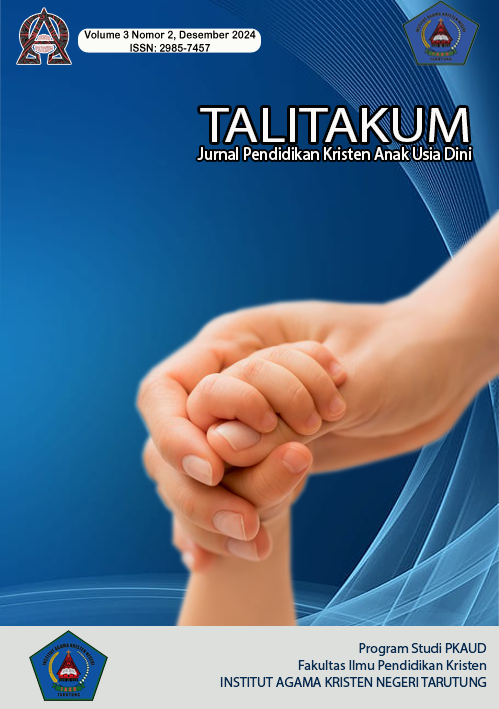EFFECTIVENESS OF THE HOOK, BOOK, LOOK, AND TOOK (HBLT) TEACHING METHOD ON THE SPIRITUAL GROWTH OF EARLY CHILDHOOD STUDENTS AT PAUD RUMAH BELAJAR BABA
DOI:
https://doi.org/10.69929/talitakum.v3i2.1Keywords:
HBLT, Teaching Method, Spiritual Growth, StudentsAbstract
This study aims to evaluate the effectiveness of the Hook, Book, Look, And Took (HBLT) method on the spiritual growth of early childhood education (PAUD) students at Rumah Belajar Baba. The research employs a qualitative approach with a case study methodology, involving in-depth observation and document analysis. Data were collected through direct observation of learning activities, interactions between educators and students, and feedback from students and parents regarding the HBLT learning process. The results indicate that the HBLT method significantly contributes to the spiritual growth of students, as evidenced by an enhanced understanding of spiritual values, emotional engagement, and daily religious practices. The discussion reveals that the integration of technology in learning provides a more interactive and personalized experience, strengthening the connection between students and spiritual content. However, challenges in implementation, such as limitations in training, mentoring, and disparities in access, need to be addressed to improve the effectiveness of this method. The study recommends broader utilization of the Hook, Book, Look, And Took HBLT with adjustments to overcome existing obstacles and enhanced training for educators to maximize the potential of this method in the context of spiritual education.
Downloads
References
Ham, Y. J. (2012). An Exploratory Study of the Relationship between Student’s Perception of Learner Centeredness and Spiritual Development among High School Male Students. Journal of Christian Education & Information Technology, 21, 115–134.
Harless, J. T. (2012). Transformational discipleship: A model for sermon-based small groups for life transformation. Liberty University.
Lee, Y. W. (2000). Relationship between spirituality types and learning styles. Torch Trinity Journal, 3, 87–105.
Patel, J. (2023). Learning to live together harmoniously: Spiritual perspectives from Indian classrooms. Springer Nature.
Ping, M. T. (n.d.). GGGGS LLLLLSLLLS GGGGS.
Ping, M. T., & Tedjaatmadja, H. M. (2013). “HOOK, BOOK, LOOK, TOOK”: EVALUATION AND REFLECTION. Petra Christian University.
Quinn, S. (2017). Student Engagement: The Hook. In Quality Learning (pp. 69–77). Brill.
Richards, L. O., & Bredfeldt, G. J. (2020). Creative Bible Teaching. Moody Publishers.
Schultz, D. M. A. (2021). Equipping Lay Elders with the Spiritual Care Skills of Active Listening, Sharing Scripture, Offering Prayer, and Providing Follow Up at St. Paul Lutheran Church in Wood River, IL.
Somantri, G. R. (2005). Memahami metode kualitatif. Makara Human Behavior Studies in Asia, 9(2), 57–65.
Tedjaatmadja, H. M., & Renandya, W. A. (2012). Hook, Book, Look, Took: Keep it simple. Modern English Teacher, 21(4), 58–61.
Tolbert, L. V. (2000). Teaching like Jesus: A practical guide to Christian education in your church. Zondervan.
Waruwu, M. (2023). Pendekatan penelitian pendidikan: metode penelitian kualitatif, metode penelitian kuantitatif dan metode penelitian kombinasi (Mixed Method). Jurnal Pendidikan Tambusai, 7(1), 2896–2910.
Downloads
Published
Issue
Section
License
Copyright (c) 2024 Yossika Priscila, Jhonnedy Kolang Nauli

This work is licensed under a Creative Commons Attribution-NonCommercial-ShareAlike 4.0 International License.






















